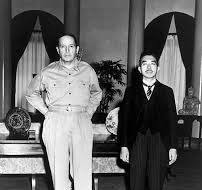Hist 199 Postwar Food Shortages: Food May Day
Background:
[T]he advice of Gen. Bonner Fellers []...convinced [MacArthur] to preserve the imperial system and rule not directly but through the Japanese government during the Occupation. The Occupation ended more than 70 years ago, with the formal implementation on April 28, 1952 of the San Francisco Peace Treaty signed on Sept. 8, 1951 between Japan and 48 other nations.
The Photo:
On Sept. 27, 1945, Emperor Hirohito called on MacArthur at the U.S. Embassy in Tokyo. A photo commemorates the occasion. It ran on the front page of the next day’s papers.
The Emperor stands rigid in a very formal morning coat. At his left MacArthur stands a head taller in casual khakis with a tieless open collar, his hands in his pockets. The photo shocked the public. It brought home the fact that SCAP occupied a realm above the Emperpr, the Son of Heaven. John Dower, author of 2000’s Pulitzer Prize-winning book Embracing Defeat, observes that the photo established “MacArthur’s authority and the fact that he would stand by the Emperor.”
MacArthur saw his mission as no less than Japan’s democratization. No other conqueror would have been as magnanimous in victory or as perceptive in realizing that Japan’s pacification lay in its democratization. The Aussies and Brits, the Filipinos, French and Dutch — all wanted harsher treatment of the conquered nation.
Food Shortages:
People survived by black-market purchases. The food shortage continued for 2 and 1/2 years. Tokyo’s first May Day rally in 11 years took place in 1946. The 500,000-strong rally turned into a movement for increased rations. The demonstrators sat down in the plaza between Imperial Palace and the Daiichi Life Insurance (Seimei) Bldg. The demonstration spread. Alarmed, GHQ on May 19 permitted the government to release flour. The following day MacArthur warned of Occupation army intervention. The demonstrators dispersed.
MacArthur, though, not only wielded a stick — but also proffered a carrot. Between Nov. 1946 and Nov. 1947, GHQ supplied the Japanese with 1,613,315 tons of grains and 43,474 tons of canned goods. The jobs of 13 million Japanese, including soldiers, vanished at the end of the war. Over the next two years 4.13 million workers were discharged. But between January and May of 1946, only 970,000 people applied for 1.3 million positions through 540 nationwide employment agencies. Those figures bespeak the fact that the employed were little better off than the unemployed as inflation ate away buying power. Male industrial workers’ average real wages in the latter half of 1946 were 27.5 percent of those in 1934-36.
These circumstances prompted GHQ to encourage the formation of labor unions. The Communist Party spearheaded their organization.
The prewar government had driven communists underground, but GHQ legalized the party.
Apparatchiks released from prison then skillfully organized unions. Red flags flew everywhere within a year of the war’s end. Unionization had boosted private-sector wages to where they were double those of civil servants.
On Nov. 28, 1946, civil servants’ unions established the Labor Committee of All Public Workers. The committee demanded a large pay hike. The government, which was broke, balked. The committee announced a General Strike to begin on Feb. 1, 1947. Ultimately, of course, Gen. MacArthur intervened to prevent the strike much to the disappointment and dismay of Japan's Union and Labor Leaders.
from: http://www.japantimes.co.jp/community/2002/04/28/general/they-came-they-saw-they-democratized/#.WKdBbRy8zY8

